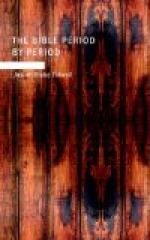The Ark. Noah built the ark according to the pattern given him by Jehovah. It was a sort of box-like boat 525 ft. long 87-1/2 ft. wide and 42-1/2 ft. deep, if we count a cubit at twenty-one inches. It was three stories high, and the building of it was a huge undertaking. We need not, however, think of it as an undertaking beyond the resources of the times. All those early people seem to have been fond of colossal works. The building of this Ark was not only an object lesson to the ungodly people of the time but a satisfactory proof of the faith of the builder.
The Flood. At the command of Jehovah Noah and his household entered the Ark carrying two of every species of unclean, and seven of every clean kind of animal and creeping things. They were shut in by the hand of God. The scripture passes silently over all horrors that filled the earth as man and beast were destroyed. We may imagine them trying by strength to get out of reach of the rising waters, but no mental culture or mechanical skill or physical culture, neither tears and entreaties could deliver man from the destruction which God had determined because of sin. It was seven months before the Ark rested on Ararat and more than five more before the ransomed company departed from it.
The Sacrifice and Rainbow Covenant. Upon leaving the Ark Noah expressed his thanksgiving and devotion to God by erecting an altar to Jehovah and offering thereon a sacrifice consisting of victims of every species of clean bird and beast. The fragrance of this sacrifice, such as the world had never seen before, was pleasant to Jehovah and he visited Noah with a promise that he would not again send such a flood upon the earth. The rainbow was given as a pledge of the promise made him. It was to be the constant seal of mercy on God’s part, and it is not necessary to worry over the question as to whether there had never been a rainbow before or whether it was simply appropriated as a sign. In this new covenant the earth was put under Noah, as it was under Adam at first. He was, however, allowed to eat flesh, only mans blood was not to be shed and the seasons were to continue in regularity. Thus the race started anew as a saved group, rescued through the faith of Noah.
Confirmation of Tradition and Geology. Perhaps no other event of scripture history has found so large a place in ancient traditions and legends as has the flood. It is found in each of the three great races-the Semites; the Aryan; and the Tutarian. It is found alike among savage and civilized races, and as might be expected is most accurate in the countries that were nearest to where the Ark rested. Among the most important of these early traditions are those of Babylon. Greece, China, and America. In a general way these traditions may be said to agree with the Biblical story in the following particulars: (1) That a flood destroyed an evil world; (2) That one righteous family was saved in a boat and that animals were saved with them; (3) That the boat landed on a mountain; (4) That a bird was sent out of the boat; (5) That the saved family built an altar and worshiped God with sacrifice. All these stories tend to corroborate the Biblical story and to show that the whole race must have spring from this common home from which they have been scattered abroad.




